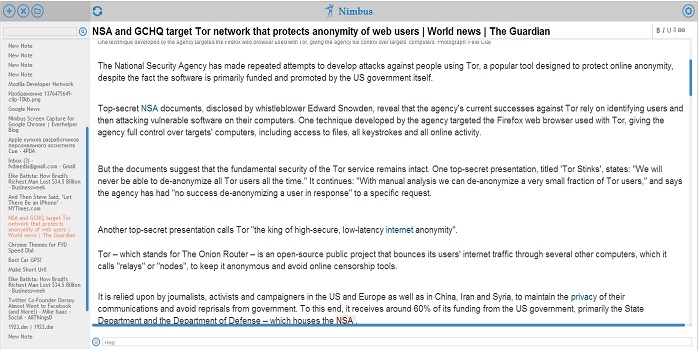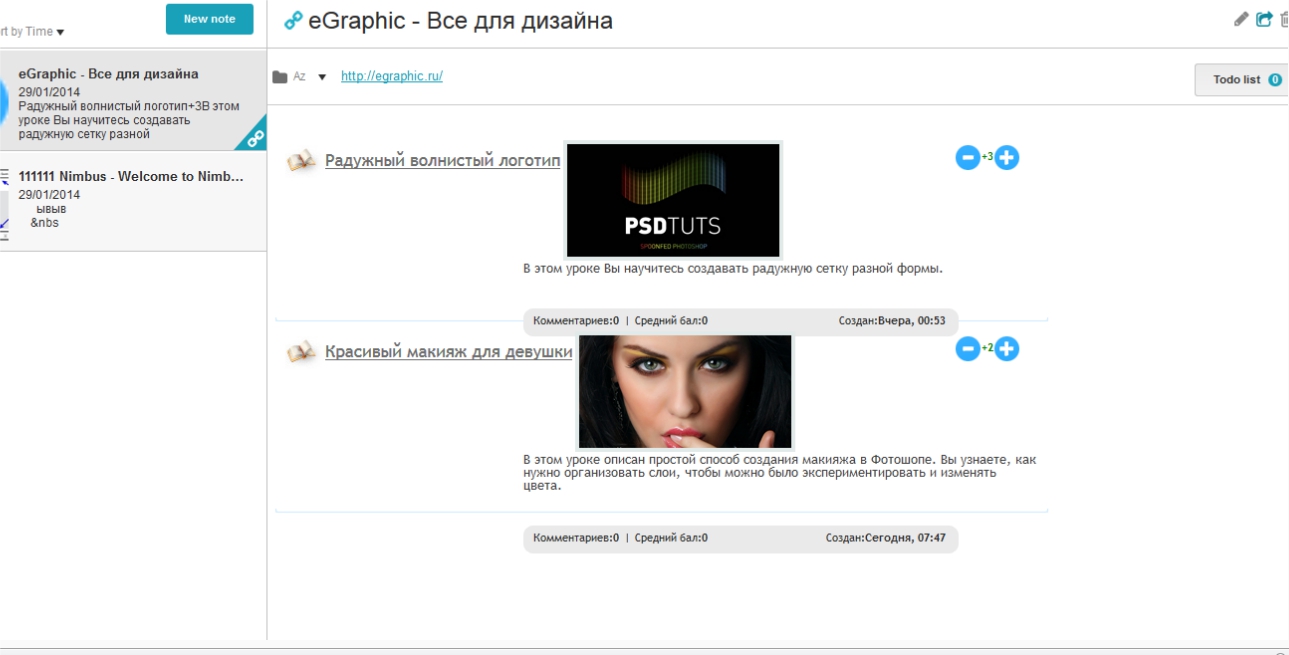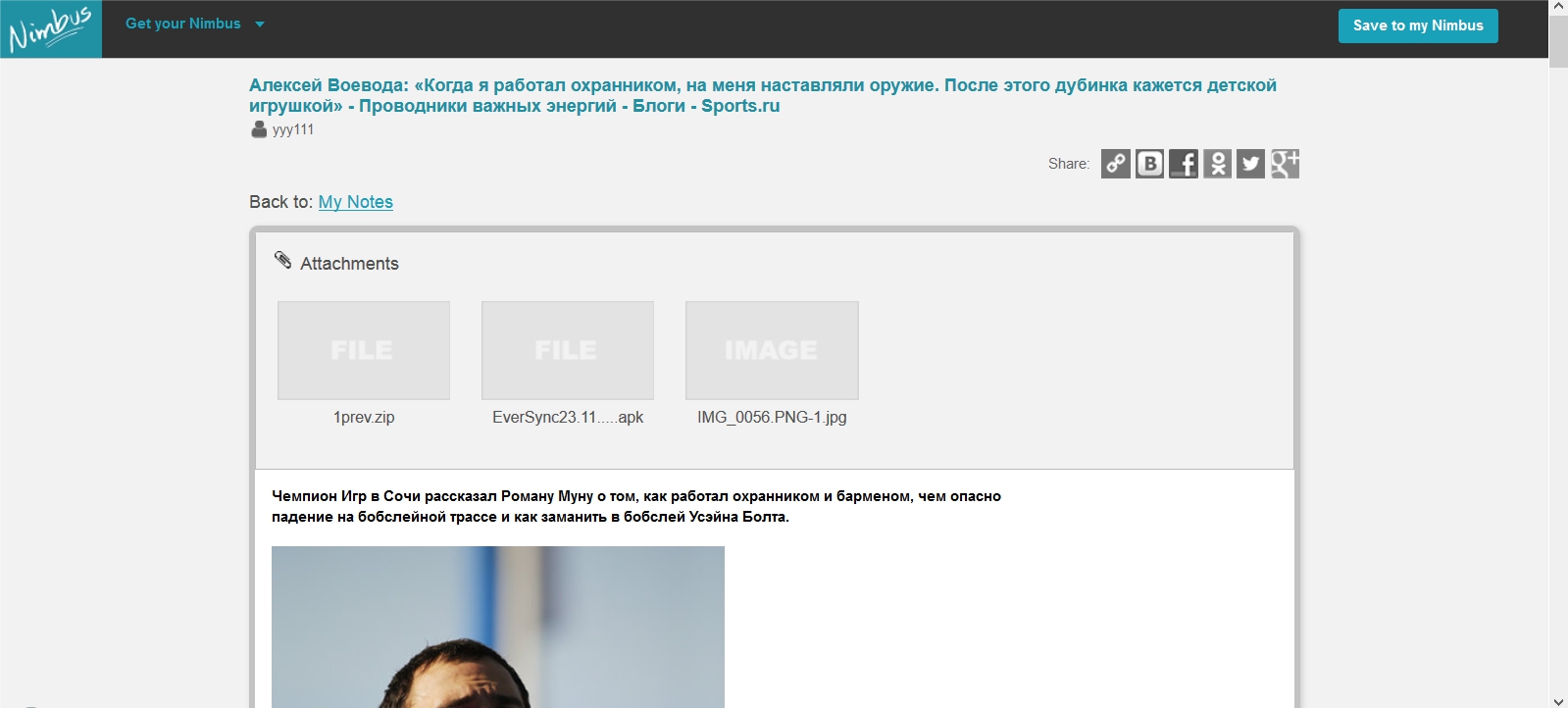Nimbus Note - Trial and Error History
It all started with a simple screenshoter ... Hardly, then in April of 2013, we could assume that the idea to finally make a normal addon for taking screenshots in Chrome would result in a large and serious cross-platform project, which Nimbus became (then the name was not) . In this post I would like to tell a brief and creepy story of the project, which, I hope, at least, will interest you.

')
First, I’ll clarify what the Nimbus Note is and why it is needed at all. If simple, then Nimbus is needed to create, edit and categorize various types of information. In the free version has a large monthly limit on traffic - 100 megabytes. There is support for attachments, offline access in mobile applications, etc. Many people call it an analogue of Evernote (it is possible that someday Evernote will be called an analogue of Nimbus :)) Something we really like (like many other applications), and something not very. In any case, we just try to do our job well, and who is like who and who is better defined by users already.
To say that the decision to make an addon Nimbus Capture was spontaneous wrong. Our team has long been engaged in the development of browser-based applications and, therefore, we understand something in this — after all, more than 50 applications. Also, we will not invent a legend about how two people met who decided to change the world. We didn’t have any global plans then, if only somewhere deep in the soul (very deeply). Initially, the application was written for itself, since dozens of screenshots must be taken on the day, and those applications that already existed did not suit us. In the first version of Nimbus and did not smell. It was possible to send only to Google Drive. Following, work has already begun on the application Nimbus Note for Chrome. And it was then that we decided to do a full service for working with notes. Then we made our first mistake - no, I have nothing against freelancers, but sometimes these characters come across characters: (As a result, there are 2 lost months, not to mention nerve cells (but at least they are being restored) We’ve finished the application , but it was impossible to watch its first release without tears (tears did not help much either.) Nevertheless, the Chrome NImbus Note application turned out to be quite functional. Folders and tags are supported, text can be formatted, search works. the application can work on p various systems, including MAC and Linux.


As I wrote above, by the beginning of the summer of 2013 we already had a goal to make a full-fledged service, especially since we already had some groundwork in the field of content synchronization (the everhelper.me service) And we started work on all fronts. Then we began to look closely at our possible competitors in order to add what they do not have and what can be useful for us. And it helped us to create clippers that give complete freedom of action while saving information from sites. For example, you can save only those parts of the page that you really need, or edit the note altogether, even before sending to the server.
Web part ... Yeah, a lot of we have suffered with it. The server part is written in Python, and the frontend on AngularJS and everything seemed to go smoothly until it was transferred to the main server. This is where the embarrassment happened. It turned out that the notes made by our legendary clipper completely break all the styles of the admin panel and the view turns out, well, at least awesome. Began to look for solutions. Tried everything and came to the conclusion that you need to write your server parser, which will result in clips of notes in a less decent form without unnecessary garbage. And while we were doing it, we began to display all the notes in the frame, which of course was extremely inconvenient due to the poor compatibility of Angular and the frame. But two months later, the parser was made, which allowed working with clip notes not only in the admin area, but also on mobile devices. If someone has interesting technical features of the parser, then we will write a separate post.

As for the other functions of the web part, it has an almost complete gentlemanly set. You can create and edit notes in a not so bad editor. Attachments of various types can be uploaded to notes, from pictures to office documents. Yes, the admin speed is still far from ideal, but the work on its optimization is underway.
A lot of controversy has been raised by the topic of attachments, namely, where to place them: in the body or all the same several separately. Both options have my plus, but decided to do it separately. It seems that this is more convenient when you can immediately see the list of files, and not search them throughout the note.

With mobile apps, adventure was also enough. Let's start with the fact that we started doing applications under IOS when IOS 7 was only introduced in beta and we had to rewrite half of the code and draw a new design. But now we fully comply with all patterns. True, we were immediately accused of being too similar to the Vesper, but it was more flattering for us :)
With Android, everything is much more complicated. Many things had to be written from scratch, even those that seem to be the default. For example, the scroll function that works smoothly for us even with a very large number of notes (checked on a folder with more than a thousand notes) or an editor who by no means wanted to work with notes made in the clipper. The above-mentioned parser made the task somewhat easier, but I still had to write my own solution. We will lay out some of our achievements in open access.
And then the work continues. Desktop versions of Nimbus Note and Nimbus Capture are being prepared for release. Work is underway on the Nimbus Shared module, which will allow entire teams to conduct group work with notes. Special thanks to our users, thanks to which the TODO list has reached a huge size :)
This is a brief and somewhat confusing history of our project, which we hope will get its continuation. I deliberately omitted most of the features of the service, since this is still a post about our work on products. If you have any questions or suggestions for service, I will be happy to answer them.

')
First, I’ll clarify what the Nimbus Note is and why it is needed at all. If simple, then Nimbus is needed to create, edit and categorize various types of information. In the free version has a large monthly limit on traffic - 100 megabytes. There is support for attachments, offline access in mobile applications, etc. Many people call it an analogue of Evernote (it is possible that someday Evernote will be called an analogue of Nimbus :)) Something we really like (like many other applications), and something not very. In any case, we just try to do our job well, and who is like who and who is better defined by users already.
The first steps
To say that the decision to make an addon Nimbus Capture was spontaneous wrong. Our team has long been engaged in the development of browser-based applications and, therefore, we understand something in this — after all, more than 50 applications. Also, we will not invent a legend about how two people met who decided to change the world. We didn’t have any global plans then, if only somewhere deep in the soul (very deeply). Initially, the application was written for itself, since dozens of screenshots must be taken on the day, and those applications that already existed did not suit us. In the first version of Nimbus and did not smell. It was possible to send only to Google Drive. Following, work has already begun on the application Nimbus Note for Chrome. And it was then that we decided to do a full service for working with notes. Then we made our first mistake - no, I have nothing against freelancers, but sometimes these characters come across characters: (As a result, there are 2 lost months, not to mention nerve cells (but at least they are being restored) We’ve finished the application , but it was impossible to watch its first release without tears (tears did not help much either.) Nevertheless, the Chrome NImbus Note application turned out to be quite functional. Folders and tags are supported, text can be formatted, search works. the application can work on p various systems, including MAC and Linux.

The first version of our addon

And so it looks now
Work is in full swing!
As I wrote above, by the beginning of the summer of 2013 we already had a goal to make a full-fledged service, especially since we already had some groundwork in the field of content synchronization (the everhelper.me service) And we started work on all fronts. Then we began to look closely at our possible competitors in order to add what they do not have and what can be useful for us. And it helped us to create clippers that give complete freedom of action while saving information from sites. For example, you can save only those parts of the page that you really need, or edit the note altogether, even before sending to the server.
Web part ... Yeah, a lot of we have suffered with it. The server part is written in Python, and the frontend on AngularJS and everything seemed to go smoothly until it was transferred to the main server. This is where the embarrassment happened. It turned out that the notes made by our legendary clipper completely break all the styles of the admin panel and the view turns out, well, at least awesome. Began to look for solutions. Tried everything and came to the conclusion that you need to write your server parser, which will result in clips of notes in a less decent form without unnecessary garbage. And while we were doing it, we began to display all the notes in the frame, which of course was extremely inconvenient due to the poor compatibility of Angular and the frame. But two months later, the parser was made, which allowed working with clip notes not only in the admin area, but also on mobile devices. If someone has interesting technical features of the parser, then we will write a separate post.

Such a dubious view was in a note without a parser, but with a frame
As for the other functions of the web part, it has an almost complete gentlemanly set. You can create and edit notes in a not so bad editor. Attachments of various types can be uploaded to notes, from pictures to office documents. Yes, the admin speed is still far from ideal, but the work on its optimization is underway.
A lot of controversy has been raised by the topic of attachments, namely, where to place them: in the body or all the same several separately. Both options have my plus, but decided to do it separately. It seems that this is more convenient when you can immediately see the list of files, and not search them throughout the note.

With mobile apps, adventure was also enough. Let's start with the fact that we started doing applications under IOS when IOS 7 was only introduced in beta and we had to rewrite half of the code and draw a new design. But now we fully comply with all patterns. True, we were immediately accused of being too similar to the Vesper, but it was more flattering for us :)
With Android, everything is much more complicated. Many things had to be written from scratch, even those that seem to be the default. For example, the scroll function that works smoothly for us even with a very large number of notes (checked on a folder with more than a thousand notes) or an editor who by no means wanted to work with notes made in the clipper. The above-mentioned parser made the task somewhat easier, but I still had to write my own solution. We will lay out some of our achievements in open access.
What's next?
And then the work continues. Desktop versions of Nimbus Note and Nimbus Capture are being prepared for release. Work is underway on the Nimbus Shared module, which will allow entire teams to conduct group work with notes. Special thanks to our users, thanks to which the TODO list has reached a huge size :)
This is a brief and somewhat confusing history of our project, which we hope will get its continuation. I deliberately omitted most of the features of the service, since this is still a post about our work on products. If you have any questions or suggestions for service, I will be happy to answer them.
Source: https://habr.com/ru/post/216895/
All Articles